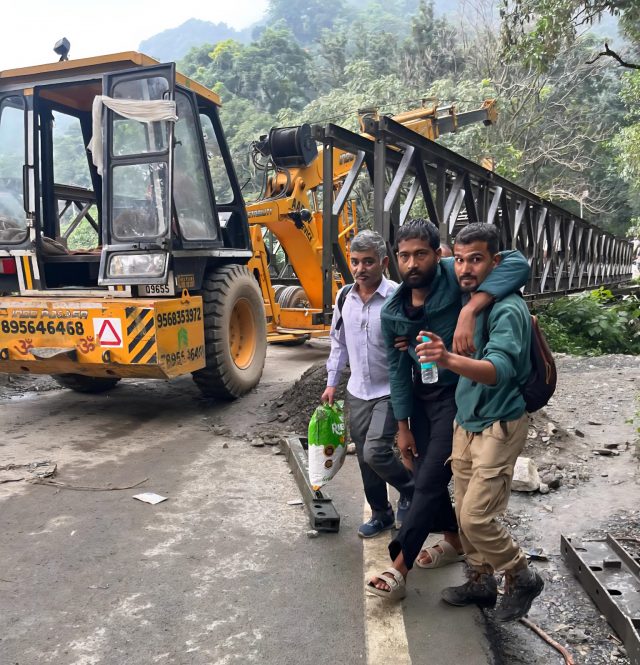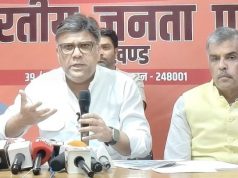By ARUN PRATAP SINGH
Garhwal Post Bureau
Dehradun, 17 Sep: More than 40 hours have passed since the devastation caused by heavy rainfall, cloudbursts and landslides in Dehradun, but the situation remains grim, and normalcy has not been restored. Many areas in and around Dehradun city still remain fully or partially cut off. The SDRF and NDRF teams have launched full-scale rescue operations but several villages continue to reel under severe disruption. Sahastradhara’s Majarda and Karligad villages have been badly affected while, in Phulet, reports emerged of six people being buried though official confirmation has not yet been received. Officials stated that the police and rescue teams received this information at around noon yesterday, but treacherous conditions delayed the SDRF teams for nearly seven hours. When they reached the spot, there was no power supply and darkness had fallen, forcing operations to resume only the following day. Rescue work is now underway in earnest.
On the Mussoorie–Dehradun route, construction of a temporary bailey bridge has commenced near the Shiv Temple, where a section of road was washed away. Sub-Divisional Magistrate Rahul Anand inspected the site and stated that debris at other affected points on the Mussoorie–Dehradun Road was also being cleared at an accelerated pace. However, the blockade of this arterial route has cut Mussoorie off from supplies of milk and vegetables, causing great hardship to both residents and tourists.
The Dehradun district administration, after securing permission from the Chief Minister, today arranged for airlifting and airdropping of ration to disaster-hit villages including Phulet, Sarkhet, Chamrauli, Silla and adjoining areas. Under the chairmanship of Sub-Divisional Magistrate Kumkum Joshi, the administration distributed 150 ration kits, each weighing 15 to 20 kg and containing essentials such as rice, pulses, flour, sugar and salt, to nearly 60 families whose road connectivity has been completely severed.
It may be recalled that the scale of devastation in Dehradun has been severe. Heavy rainfall paralysed traffic across Haridwar, Mussoorie and Paonta Sahib routes. At Premnagar, a bridge collapse forced traffic diversions, while along the Dehradun–Paonta highway the Tons River overflow washed away a portion of a bridge, completely blocking the route. With the Mussoorie road also damaged, tourists remain stranded without any alternative passage. Machinery has been pressed into service to restore connectivity, and while the route to Haridwar has been reopened, the damaged bridge near Premnagar still requires diversion of traffic.
The Mussoorie route is expected to take three to four days before full restoration.
It may be recalled that calamities are far more common in the hills and Dehradun usually plays a crucial role in providing relief to hill districts during monsoon calamities. Yet this time, the city itself has borne the brunt of nature’s fury. From Dharali to Tharali, disasters have often struck in the mountains with Doon serving as the hub for rescue, but on this occasion, Dehradun itself has become the epicentre of destruction. Karligad has witnessed calamity of this level last in 2011, when a deadly cloudburst had claimed several lives, and similar events were seen in the Song and Bindal valleys, but those incidents were relatively localised. This year, however, when the monsoon was believed to be in retreat and repairs on rain-damaged roads had already begun, unexpectedly, a sudden deluge unleashed havoc, altering the face of the city.
There is hardly an outer area of Dehradun left untouched by the disaster, with deep scars of destruction visible everywhere. Residents wear expressions of grief and anguish, asking why nature has inflicted such fury upon them. The swelling of rivers following heavy rainfall since Monday night worsened the crisis. The Tons River at Premnagar gained dangerous momentum, sweeping away part of the bridge at Nanda Ki Chowki and blocking the Dehradun–Paonta national highway. The Police have diverted traffic via Panditwari Rangadwala Tiraha for vehicles heading from Dehradun towards Vikasnagar, while incoming traffic from Vikasnagar was rerouted through Sighniwala Tirahe. For safety reasons, police personnel have been deployed on both sides of the damaged bridge.
The present disaster has also wreaked havoc on electricity infrastructure, sweeping away poles, lines and equipment, and disrupting supply to 571 villages. The officials estimate losses in excess of Rs 10 crore across Dehradun district alone. The power supply divisions including Dehradun North, Central, South, Doiwala, Rishikesh, Mohanpur, Vikasnagar and Raipur have reported extensive damages, crippling electricity distribution across both urban and rural areas.
Dehradun and Mussoorie currently present a picture of devastation with lives lost, families cut off, tourists stranded, communication crippled and infrastructure battered. Relief operations have been intensified, but the city and its surrounding villages continue to await full restoration. Meanwhile, the fresh weather alerts warn of more rainfall in the coming days.






